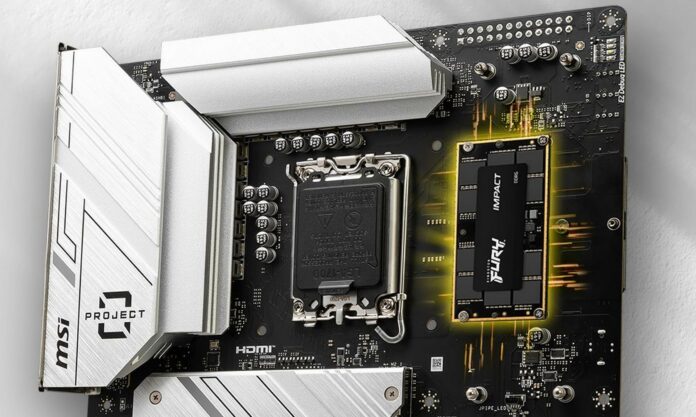MSI has teased a collaboration with Kingston on a Project Zero motherboard featuring Fury CAMM 2 DDR5 RAM. The board trades its good old DIMM slots for the fresh CAMM connector.
The Dragon brand is preparing for the future as it starts to adopt the latest in RAM standards: CAMM 2. Taking its Project Zero motherboard as a basis, MSI has swapped the well-known DDR5 DIMM slots for a CAMM 2 socket. For this first edition, MSI went with a single socket in place of four DDR5 UDIMMs. Though, in theory, this means reduced capacity, most users only fill two out of the four, thus CAMM 2 should provide more capacity and speed.
CAMM (Compression Attached Memory Module) is Dell’s new memory module design, which uses an LGA (land grid array) socket akin to Intel and AMD desktop CPUs. The idea behind CAMM is to overcome the technical limitations of traditionally slotted DIMM modules. This new format thus allows higher memory speeds while consuming less power. It’s ideal for battery powered devices where it first saw the light of the day.
CAMM, or CAMM 2 in this case, provides up to 128GB per module at speeds above 6,400MT/s. The latter is hard to achieve on laptops which tend to stick with 5,600MT/s SODIMM RAM, putting it in an advantageous position. However, on the opposite side, CAMM modules can’t be simply slotted, as they use a mounting system with six screws. This makes them a bit harder to upgrade than regular DIMMs.
Something that may come as an after-effect if everyone adopts the CAMM format is cheaper RAM. Since laptops can use CAMM modules, it means that we no longer need different formats – UDIMM and SODIMM – for desktop and mobile PCs. Things could get even more interesting for those buying from the second-hand market due to the increase of CAMM RAM sources. Of course, this is all assuming CAMM manages to get traction to begin with.
Personally, I don’t mind switching to CAMM 2 if the price is right, but I just feel brands should wait for DDR6. Releasing it now will only segment the market further. It’ll be interesting to see how much performance this standard can muster before requiring super high-end boards to function. Currently above 7,400MT/s UDIMM DDR5 requires good boards to boot.
MSI will provide further details about the Z790 Project Zero Plus motherboard during Computex in a couple of weeks, so stay tuned.


